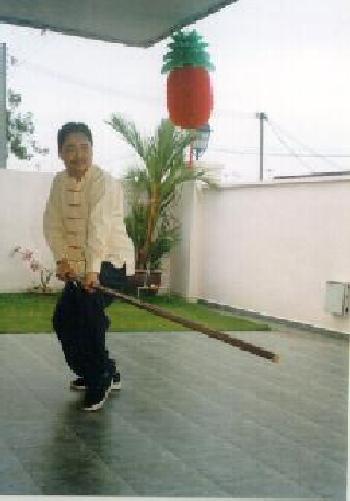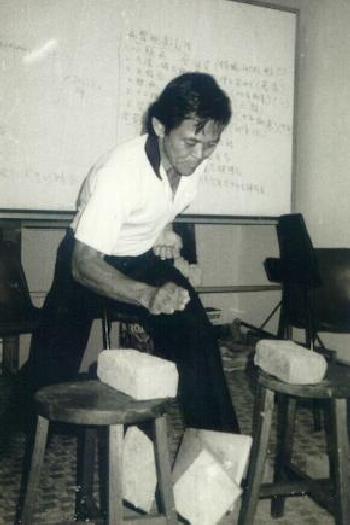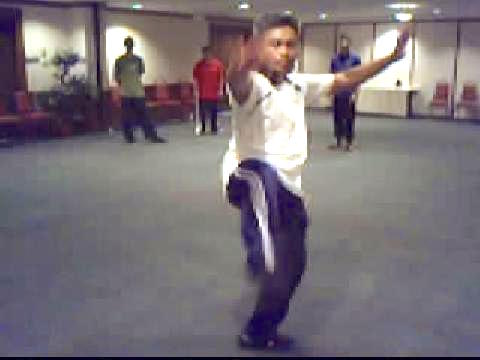May 2006 (Part 1)
SELECTION OF QUESTIONS AND ANSWERS

Sifu Goh Kok Hin, a senior disciple of Sifu Wong, performing the Flowing Water Staff. You can view video clips of the Flowing Water Staff here.
Question 1
I have bought Sifu Wong's book, “The Art of Chi Kung”. I think it is a wonderful book about chi kung. Thank you very much for sharing the wonderful art of chi kung to people in general. I have a few questions about some of the chi kung exercises.
In Abdominal Breathing when we breath good cosmic chi, does it not flow out when we breath bad chi out, or is the good chi amassed in the dan tian (qihai) when we breath in. In Tai Ji Quan breathing we sink the chi into the dan tian when we breathe out.
— Jefferson, USA
Answer
In Abdominal Breathing and Reverse Breathing, we perform both breathing in and breathing out.When an ordinary person breathes in, both good chi and bad chi flow in, but the amount of good chi is more. When he breathes out, both good chi and bad chi flow out, but the amount of bad chi is more. A chi kung practitioner enhances this natural breathing process by using appropriate breathing techniques and methods, such as Abdominal Breathing and Reversed Breathing. In other words, the proportion of good chi to bad chi while breathing in, and the proportion of bad chi to good chi while breathing out are greater. Hence he is more efficient than ordinary people in this respiratory process as well as in other physiological processes.
One common and effective way to enhance these proportions is to use the mind. When you breathe in, gently think that you breathe in good chi, and when you breathe out, gently think you breathe out bad chi.
It is very important — I repeat, it is very important that this must be done gently, and that you must not intellectualize. You need not do this every time you breathe. In ten breathes, it is sufficient to think of the process gently about two or three times.
But if you do not feel confident or comfortable doing this, it is better to leave out this gentle thinking or visualizing. Just breathe in gently through your nose, and breathe out gently through your mouth.
In Abdominal Breathing, chi gently sinks into the dan tian when breathing in. In Reverse Breathing, chi gently sinks into the dan tian when breathing out. The breathing method you use in your Taijiquan training is Reverse Breathing.
This does not necessarily mean that only Reserve Breathing is used in Taijiquan. Most schools use spontaneous breathing, many schools use Reversed Breathing, some use Abdominal Breathing, and a few, like ours, use whatever mode of breathing is best for the occasion.
For example, in Wahnam Taijiquan as well as Shaolin Kungfu, when we first learn some forms, we do not worry about our breathing, we just breathe spontaneously. Later, if we wish to conserve our energy for a long series of many movements, we use Abdominal Breathing. If we wish to strike with internal force, we use Reverse Breathing.
At advanced stage, we go back to spontaneous breathing, but this spontaneous breathing is very different from the spontaneous breathing at the beginners' stage. In the spontaneous breathing of the advanced stage, our breathing regulates itself in its best manner for the occasion.
Question 2
In “Nourishing Kidneys” you say to visualize chi at one's lao gong (centre of palms). Do you mean to simply visualize energy at the lao gong or do you mean to send the chi we had already sent to bai hui to the lao gong? When I breathe in when I'm raising I feel chi from my breathing flowing to my hands. Is this correct?
Answer
It is good that you ask this question. It is the type of questions many dedicated practitioners ask, and it is also the type of questions that are likely to cause them deviations and side-effects.
The best advice for you is to just follow the instructions. Do not intellectualize, and do not add anything not mentioned in the instructions.
If the instruction is “visualize chi at the lao gong”, you just do that. Don't intellectualize like asking “What happens when I visualize chi at the lao gong?” or “Does the chi flow from the lao gong or to the lao gong?”
Also, don't add anything not mentioned in the instruction, like sending chi from your bai hui to your lao gong, or letting chi flow from your arms to your lao gong.
This doesn't mean that it is wrong practice if chi flows from your bai hui or your arms to your lao gong. It also doesn't mean that it is wrong practice if chi does not flow from your bai hui or your arms to your lao gong.
But it does mean that if the instruction is “visualize chi at your lao gong”, you just do that. If it is necessary that you must visualize the chi from your bai hui or from your arm, then it will be mentioned in the instruction. If it is not mention, you just don't worry about it.
Question 3
When doing “Pushing Mountains” you say that when pushing out to visualize chi flowing from the back to one's palms. Should one simply visualize the chi coming or should we visualize it coming from a specific point like from qihai?
Answer
As explained in the answer above, if it is necessary for you to visualize the chi coming from a specific point, it will be mentioned in the instruction. If it is not mentioned, that means you need not, and should not, do it or worry about it.
Let us take some simple examples. If the instruction is “Breathe in”, you just breathe in. You don't have to worry whether you should breathe in gently or breathe in forcefully, whether you should breathe in through your nose or breathe in through your mouth.
But if the instruction is “Breathe in gently”, then obviously you have to breathe in gently, but you need not have to worry whether you should breathe in through your nose or through your mouth. You also need not have to worry how gently is gently.
If the instruction is “Breathe in gently through your nose”, you just do that. You don't have to worry whether you should breathe in gently through your nose into your lungs or into your abdomen, whether you should be wearing a yellow shirt or a brown hat, whether you should eat hamburger or drink tea afterward. You just breathe in gently through your nose. This is following the instruction.

Sifu Cheng Chang Shou, a senior disciple of Sifu Wong, employing Cosmos Palm to break a piece of marble with an apparently gentle tap
Question 4
What should I do after I have developed the Cosmos Palm to break a brick? Channel chi into my relaxed palm to break the brick?
Answer
You should strike your Cosmos Palm on a brick to confirm that you could break a brick and not your hand. It would be helpful to choose a soft brick to start with to gain confidence. Gradually you can progress to harder bricks.
Yes, you channel your chi to your palm for the brick breaking. Your arm is relaxed but your palm is terse, due to your chi consolidated there. If your palm is relaxed, your flowing chi may not be sufficient to break the brick. This does not mean you tense the muscles of your palm.
A good analogy is a water hose. If you use a water hose to break a brick, it is not the flowing water that does the breaking, but the momentum of the hose made hard by the flowing water. In the same way, it is not the flowing chi that breaks the brick but the momentum of your palm made solid by your flowing chi.
Striking an opponent is different from breaking a brick. When a Cosmos Palm master strikes a person, it is not the momentum of his palm, but his flowing chi channeled by him into the opponent that causes serious injury. The master's chi distorts the energy network of the opponent, which results in upsetting the normal working of the person's organs or system. There may not be any external mark on the point of contact, yet the opponent can be seriously injured. Hence, the palm of a Cosmos Palm master may be soft and gentle, and he may be unable to break a brick, but he can cause serious damage to an opponent.
Question 5
I am a Taijiquan practitioner and am capable of using fa-jing to send my opponents fly away with a palm strike. My desire is to learn Cosmos Palm as an addition to my other energy skills.
Answer
You have to learn it from a master who is willing to teach you. Of course, Cosmos Palm is not just for sending an opponent flying away. It can be used for healing, and it gives the exponent radiant health.
Question 6
Is the fa jing (striking force) of Taijiquan equal or related to the Cosmos Palm? Can it also cause internal injury when used on ordinary people?
Answer
“Fa-jing” or explode force refers to techniques, whereas Cosmos Palm refers to force. One can use other forms of force, such as dan tian force and Small Universe, to “fa-jing”. On the other hand, besides being used for “fa-jing”, Cosmos Palm can be used for other purposes, such as opening energy blockage and massaging internal organs.
A Taijiquan practitioner may use Cosmos Palm or other forms of force to “fa-jing”. Whether these other forms of force are superior or inferior to Cosmos Palm depend on the attainment of the practitioner in these forms of force. If he is a master using dan-tian force to “fa-jing”, for example, his force is likely to be greater than that of a Cosmos Palm student. If the Taijiquan practitioner is a student, his fa-jing using dan tian force is likely to be lesser than that of a Cosmos Palm master.
“Fa-jing” using Cosmos Palm or other forms of force normally can cause internal injury on ordinary people. But the “fa-jing” of ordinary Taijiquan practitioners, who usually use dan tian force, and the “fa-jing” of Iron Palm practitioners normally have no harmful effect on masters with Iron Shirt or Golden Bell. However Cosmos Palm masters as well as powerful Taijiquan masters and powerful Iron Palm masters may cause damage to Iron Shirt or even Golden Bell masters.
Due to the nature of the striking force involved, presuming that a Cosmos Palm master, a Taijiquan master and an Iron Palm master have equal force, the internal injury caused on Iron Shirt and Golden Bell exponents is greatest by the Cosmos Palm master and least by the Iron Palm master. However, if these three masters were to break bricks, the Iron Palm master will be the most effective, and the Cosmos Palm master the least effective.
Question 7
What is the skill that Shaolin fighters use to hit two bricks on top of one another and to break only the one at the bottom?
Answer
This art is called “Kak San Ta Ngow”, which literally means “Striking a Buffalo Beyond a Mountain”. The two skills involved are mental focus and internal force.

Joko using chi flow instead of muscles to perform a Taijiquan set at the Intensive Taijiquan Course of January 2006 in Malaysia. A video clip showing this performance will be released later.
Question 8
I have learned fa-jing and da-jing in my Taijiquan training. Do your Taijiquan students learn more energy techniques besides these two?
Answer
Yes.
In Wahnam Taijiquan, “fa-jing” (explode force) and “da-jing” (strike force) are basic skills taught to beginning students. You can view video clips showing beginning students at my Intensive Taijiquan Course as well as regional Taijiquan courses learning these skills.
They also learn other basic skills like building energy at their dan tian, generating an internal energy flow, using energy flow to clear injuries sustain in sparring, using energy flow to develop internal force, using energy flow to sense an opponent's intention and momentum, and regulating energy flow so that they may spar for an hour or two without being out of breath.
Advanced students deepen these basic skills. They also learn advanced skills like using their energy flow (instead of muscles) to direct physical movements, and radiating their energy from their dan tian to merge with the Cosmos.
Question 9
I had been researching the San Soo (Choi Li Ho Fut Hung) history for many years, and had just came across your Q/A in your website regarding the topic. I had found that my grandmaster trained under the Hung Sing Choy Lee Fut teacher Chan Sai Hung for a short time. So I believed that there's where four of the five words Choi Li Fut Hung came from. The only remaining “Ho” has always been the missing piece for the whole picture. You mentioned the “Ho” family could have come from Lan Tau Ho. Can you please share more about him?
— Denny, USA
Answer
Lan Tau Ho was a famous Shaolin master living about a hundred years ago in Guangdong in South China. “Lan Tau Ho” was actually his nickname, which means “Ho with a Sore Head”.
If I am not mistaken, Lan Tau Ho was a disciple or a grand-disciple of the Venerable Sam Tuck, who in turn was the second most senior disciple of the Venerable Chee Seen, the First Patriarch of Southern Shaolin Kungfu who built the southern Shaolin Temple on the Nine-Lotus Mountain in Fujian Province of South China.
Lan Tau Ho's best arts were the Flowing Water Staff and the Tiger-Tail Kick. Once while he was sparring with his sifu using staffs, he was hit on his head by his sifu with the pattern called “Phoenix Dots Head”, which caused a sore. For some odd reason, this sore never healed, which led to his nickname.
Lan Tau Ho kept this staff set within the Ho family; he never taught it to non-Ho members, not even to his inner-chamber disciples. Nevertheless, when this staff set was passed down to my sifu, Sifu Ho Fatt Nam, he taught it to a few selected disciples outside the Ho family.
It is interesting that the techniques in the Flowing Water Staff is very similar to those in the famous Six-and-Half-Point Staff (Lok Tim Phun Khuan) of Wing Choon Kungfu. It shouldn't be a surprise when we know that both sets came from the Venerable Chee Seen, the First Patriarch of Southern Shaolin. Chee Seen taught the same staff set to Sam Tuck and Leong Yi Tai, which are passed down to posterity as Flowing Water Staff and Six-and-Half-Point Staff respective. It is illuminating that the Six-and-Half-Point Staff is perfromed mainly in the wide Bow-Arrow Stance and False-Leg Stance, and not in the narrow Four-Six Stance characteristic of the fundamental Wing Choon set, Siu Lin Tau.
There was also another interesting story about Lan Tau Ho's Tiger-Tail Kick. His inner-chamber disciple, Thong Ka Lok, was dying to learn it, but his sifu did not teach him.
So one night when Lan Tau Ho was asleep, Thong Ka Lok wore a mask and sneaked into his sifu's room to attack him. Lan Tau Ho was surprised that the masked intruder used the same kungfu as his, but Thong Ka Lok was so skilful that Lan Tau Ho was nearly defeated. In his last resort, Lan Tau Ho executed the Tiger-Tail Kick, which sent Thonk Ka Lok flying backward.
“I've got it,” Thong Ka Lok murmured weakly as he took out his mask to reveal who he was. It took Lan Tau Ho many days of Shaolin medical treatment to nurture Thong Ka Lok back to health.
LINKS
Selected Reading
- Shaolin Traveling Dragon Sword by Sifu Wong — Old Video
- Pattern Practice — Happy Bird Hops up Branch
- Special Shaolin Kungfu Course — Experiences
- What is Wahnam Taijiquan
- The Beauty, Speed and Effectiveness of Kungfu Free Sparring
- Great Kungfu is a Process of Spiritual Cultivation
- A Glimpse into a VIP Taijiquan Course
